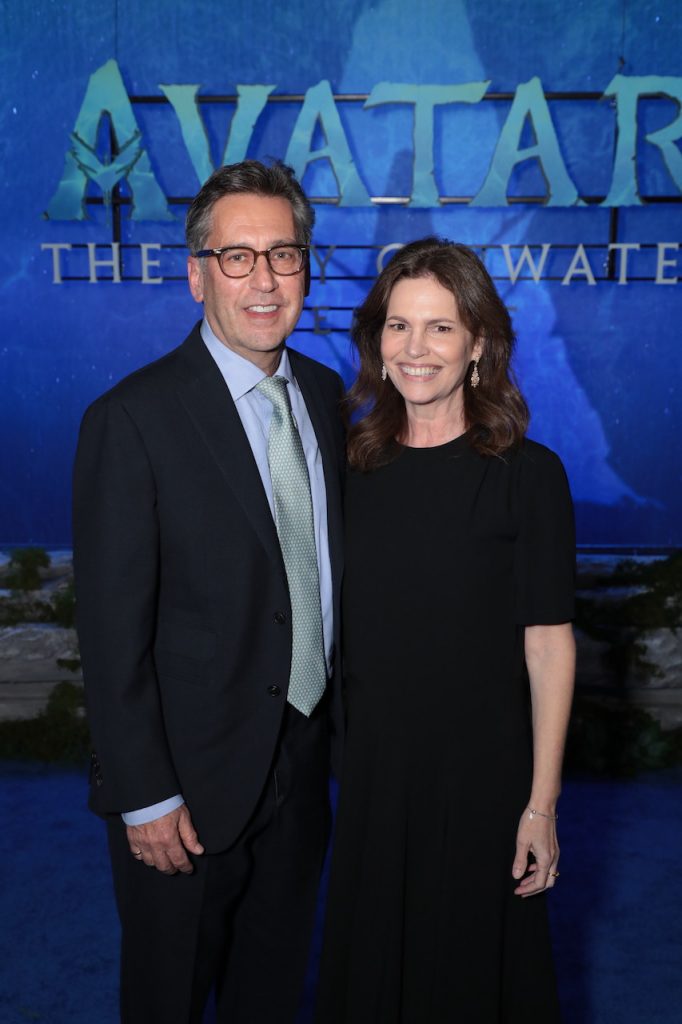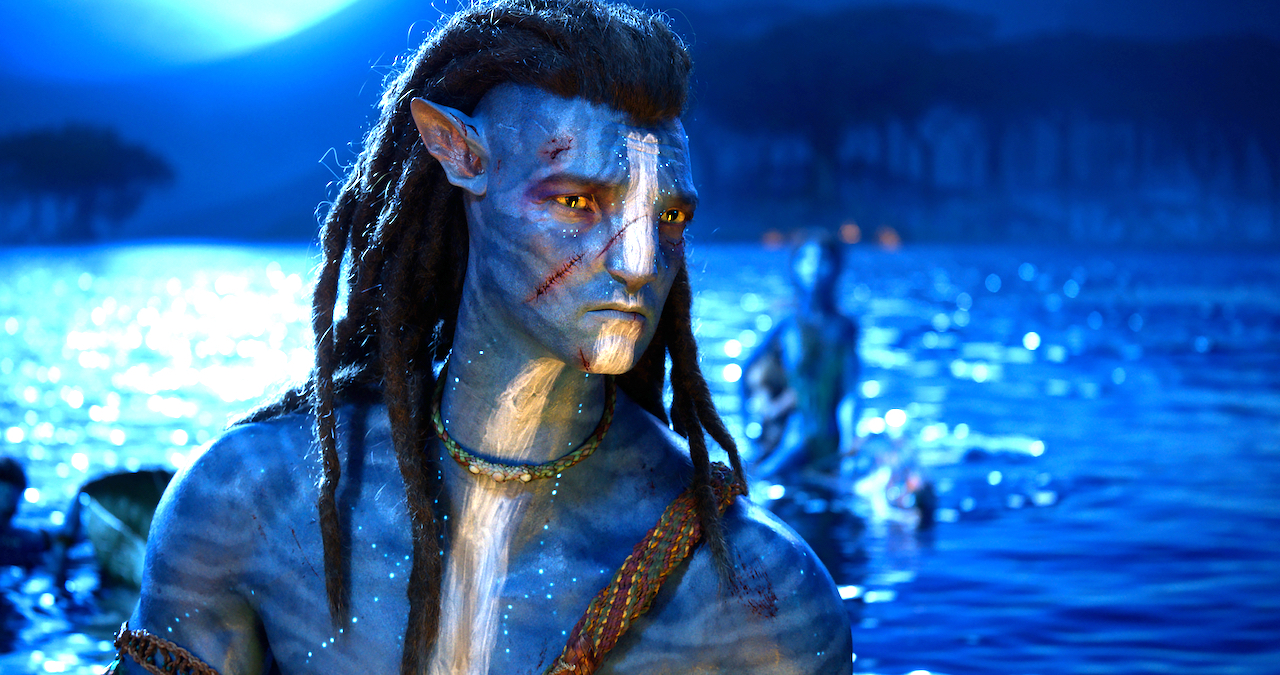- James Cameron, Rick Jaffa & Amanda Silver On “Avatar: The Way Of Water” (Part 1)
- James Cameron, Rick Jaffa & Amanda Silver On “Avatar: The Way Of Water” (Part 2)
Choosing The Writers
There is no doubt that James Cameron could handle all the writing duties on the Avatar franchise so he set up a writers’ room typically reserve for television series from the beginning. His writers’ room comprised Josh Friedman, Shane Salerno, Amanda Silver, and Rick Jaffa to flesh out the Avatar vision.
In selecting them, “I chose familiarity, comfort, and desire to be in the science world and tell these stories from a humanistic perspective,” declared Cameron. He also selected his writers based on their collaborative ability in the writers’ room – which many film writers don’t experience. They typically receive notes from studio executives, producers and directors. “I laid the seeds and the writers help me pay them off over two or three films,” continued Cameron.
Rick Jaffa and Amanda Silver have writing credits on the Planet Of The Apes and Jurassic Park franchises, so they are experienced in the scope of big movies. “We planned the Planet Of The Apes story for two or three films and planned Caesar’s journey from the start to finish,” recalled Jaffa. It was the same over-arching three act structure process they used in Avatar.
“We have a beginning, middle, and end a proximal culmination while planting the seeds for where you’re going next,” added Cameron. These are the tendons that link each movie. “There are interpersonal characters problems that don’t get resolved and carry over into the next film,” he continued. “There may be a temporary resolution, but the underlying issues remain.”
Rick Jaffa and Amanda Silver didn’t have to “apply” for this writing gig. Nor did they have to pitch their “take” on the material along with a slew of other screenwriters. “We just talked a little,” confessed Amanda nonchalantly. James Cameron had already seen their Planet Of The Apes films so he knew they were more than capable of writing Avatar: Way Of Water.
“In terms of the writing process, the path of Rick and Amanda was harvesting what they knew from their lives as parents, as siblings and family members. I wanted them to bring that unabashedly to the table,” declared Cameron. Avatar: Way Of Water was more than a blended family story. “It was therapeutic. We were all working out our family stuff.”
James Cameron implemented this family therapy session template in his writers’ room. “It wasn’t this egocentric, sniping dynamic between the writers. It was very egalitarian and everyone had their say.” The writers’ team spent around six months convening before the screenplay was locked down. “After a few weeks we could say anything, run with it and see where it went. We may or may not have used it, or it morphed.” He described his memory as being “spacial and visual” to the point of where everyone was sitting in the room.
Jake Sully lives as chief of the Omaticaya clan, and raises a family with Neytiri, which includes sons Neteyam and Lo’ak (Britain Dalton) daughter Tuktirey (Trinity Jo-Li Bliss), and an adopted daughter Kiri (Sigourney Weaver). Neteyam and Lo’ak were subconsciously drawn from one of Rick’s friend’s relationship with his brother and Kiri has a basis in Rick and Amanda’s adopted daughter in real life. These intricate references and familiar relationships packed a mighty emotional wallop in the movie.

Rick Jaffa & Amanda Silver. Photo by Alex J. Berliner/ ABImages
“Jake’s struggles to protect his family from Miles Quaritch is something I related to from the get to,” Jaffa continued. Amanda built out the scenes of Kiri hiding her light under a bushel because she couldn’t expose who she was to the world.
Writing The Billion Dollar Movie
James Cameron has been awarded by the Billion Dollar Movie Club. But box office doesn’t phase him. It’s a natural extension of writing an entertaining film. He considers the cultural, social, political considerations in every screenplay he writes regardless of its box office.
“Considering how a global audience reacts to a theme is a given,” he stated. Jaffa, Silver, and Silver spent the first few days defining why the first Avatar movie worked in terms of a “pan-cultural” perspective. “We needed to understand what made it resonate in China, France and Latin America.” Cameron didn’t want to tell the same story of imperialism and ecology, but they had to strip their first movie down to first guiding principles. The super stories were braided together with themes of difficult love, greed, and torn family loyalties.
“Another theme we discussed was a sense of belonging and earning being accepted into a foreign clan. Then it became your duty to fight for the people who accepted you,” added Cameron. This theme became especially relevant in the teenage stories where they are looking for identity, acceptance, and finding their place in the world.
“We also knew we were dealing with issues of a mixed race family,” he added. Avatar: Way Of Water explored the paradox of belonging to both and belonging to neither clan. Jake’s children are half-human, half Na’vi and his wife is full-blooded Na’vi. “How does that affect their integration into her culture and the psychology of the children and their acceptance or rejection of it?” These social problems formed many discussions in the writers’ room. Cameron confessed that he didn’t grow up in a mixed-race family, but Rick and Amanda have. “I’m intrigued by problems and challenges that are going to help me grow and understand things about the world as well,” Cameron added.
Writers can and should be cognizant of telling stories to global audiences. “Be brave about making it more personal,” stated Amanda Silver. “It’s amazing to see that human beings (or aliens) no matter where they’ve in the world, have similar feelings that you can connect across social, geographical, cultural and political lines with emotion,” she advised. “We brought the personal into the characters as much as we could.”
Curiously, “Avatar: The Way Of Water has a diverse cast, but it’s told through the lens of blue [Na’vi],” commented Cameron. Every human is an outsider in Pandora, but not in an “us” versus “them” context. “It’s not about bad humans and good aliens. It’s about good and bad humans being represented by the made-up metaphor of the ‘alien’ race. The Na’vi represent the best of humanity, so there’s a piece of us in them.”
Amanda Silver commented on the broader use of non-humans to explore humanity in science fiction movies. “It’s helpful to use the blue filter of the Na’vi to explore and celebrate racial themes and differences. You can also explore conflict a little more safely with the distance science fiction provides.”
Spirituality vs Morality
The Avatar franchise straddles both morality and spirituality in its stories. Morality is somewhat more tangible in its messaging, whereas spirituality is more personal. “We needed to touch on that which is subconscious,” said Cameron. “That which Carl Sagan described as ‘the numinous.’ The greater thing that we’re all groping to understand either through formal religion or spiritual or shamanic traditions.” He confessed that they even wrote a screenplay lacking in these spiritual elements, but quickly discarded it.
“The moral and ethical aspects of Avatar ask what is right in relation to shelving world around us?” James Cameron proclaimed that the global population gets it. When they kill the Tulkun, audiences feel the pain given the spiritual significance to the Metkayina clan. Despite the killings, there is hope. We can change course and resolve our issues.
To conclude, we asked the writers what moment in The Way Of Water meant the most to them. “For me, it was when Payakan (a Tulkun) befriended Lo’ak (Jake’s son) and they touch hand to fin,” said Silver. Jaffa concurred. That moment of co-operation and collaboration was monumental. “It’s a beautiful connection across species.”
For Cameron, the quintessential moment in his film occurred when Kiri turns to Jake and says, “Mighty. It gets me every time. Everybody feels the power of the invisible world that stands behind what she’s saying.“
